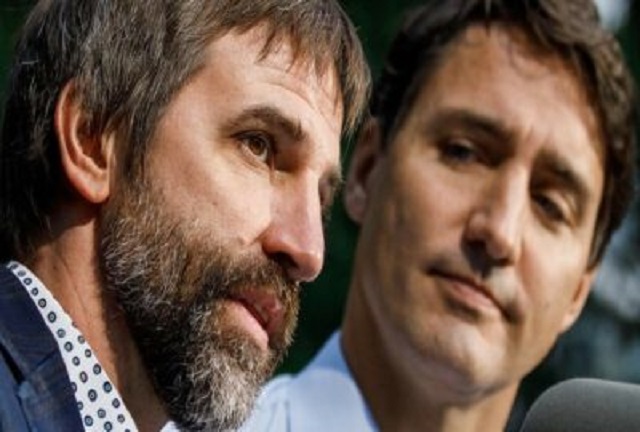Energy
Why Eastern Canada Needs to Support Western Provinces and Reject the Government’s Energy Policies

From EnergyNow.ca
By Catherine Swift
There are currently about 400 different laws, regulations, taxes and other measures in Canada that serve as greenhouse gas (GHG) reduction measures. No one has a clue which of them are effective or useless or how much they are damaging our economy and reducing Canadians’ standard of living needlessly.
Daily Caller
Blackouts Coming If America Continues With Biden-Era Green Frenzy, Trump Admin Warns


From the Daily Caller News Foundation
By Audrey Streb
The Department of Energy (DOE) released a new report Monday warning of impending blackouts if the United States continues to shutter power plants without adequately replacing retiring capacity.
DOE warned in its Monday report that blackouts could increase by 100% by 2030 if the U.S. continues to retire power plants without sufficient replacements, and that the electricity grid is not prepared to meet the demand of power-hungry data centers in the years to come without more reliable generation coming online quickly. The report specifically highlighted wind and solar, two resources pushed by Biden, as responsible for eroding grid stability and advised that dispatchable generation from sources like coal, oil, gas and nuclear are necessary to meet the anticipated U.S. power demand.
“This report affirms what we already know: The United States cannot afford to continue down the unstable and dangerous path of energy subtraction previous leaders pursued, forcing the closure of baseload power sources like coal and natural gas,” DOE Secretary Chris Wright said. “In the coming years, America’s reindustrialization and the AI race will require a significantly larger supply of around-the-clock, reliable, and uninterrupted power. President Trump’s administration is committed to advancing a strategy of energy addition, and supporting all forms of energy that are affordable, reliable, and secure. If we are going to keep the lights on, win the AI race, and keep electricity prices from skyrocketing, the United States must unleash American energy.”
Dear Readers:
As a nonprofit, we are dependent on the generosity of our readers.
Please consider making a small donation of any amount here.
Thank you!
All regional grid systems across the U.S. are expected to lose reliability in the coming years without the addition of more reliable power, according to the DOE’s report. The U.S. will need an additional 100 gigawatts of new peak hour supply by 2030, with data centers projected to require as much as half of this electricity, the report estimates; for reference, one gigawatt is enough to power up to one million homes.
President Donald Trump declared a national energy emergency on his first day back in the Oval Office and signed an executive order on April 8 ordering DOE to review and identify at-risk regions of the electrical grid, which the report released Monday does. In contrast, former President Joe Biden cracked down on conventional power sources like coal with stringent regulations while unleashing a gusher of subsidies for green energy developments.
Electricity demand is projected to hit a record high in the next several years, surging 25% by 2030, according to Energy Information Administration (EIA) data and a recent ICF International report. Demand was essentially static for the last several years, and skyrocketing U.S. power demand presents an “urgent need” for electricity resources, according to the North American Electric Reliability Corporation (NERC), a major grid watchdog.
Wright has also issued several emergency orders to major grid operators since April. New Orleans experienced blackouts just two days after Wright issued an emergency order on May 23 to the Midcontinent Independent System Operator (MISO), the regional grid operator covering the New Orleans area.
Alberta
Cross-Canada NGL corridor will stretch from B.C. to Ontario

Keyera Corp.’s natural gas liquids facilities in Fort Saskatchewan. Photo courtesy Keyera Corp.
From the Canadian Energy Centre
By Will Gibson
Keyera ‘Canadianizes’ natural gas liquids with $5.15 billion acquisition
Sarnia, Ont., which sits on the southern tip of Lake Huron and peers across the St. Clair River to Michigan, is a crucial energy hub for much of the eastern half of Canada and parts of the United States.
With more than 60 industrial facilities including refineries and chemical plants that produce everything from petroleum, resins, synthetic rubber, plastics, lubricants, paint, cosmetics and food additives in the southwestern Ontario city, Mayor Mike Bradley admits the ongoing dialogue about tariffs with Canada’s southern neighbour hits close to home.
So Bradley welcomed the announcement that Calgary-based Keyera Corp. will acquire the majority of Plains American Pipelines LLP’s Canadian natural gas liquids (NGL) business, creating a cross-Canada NGL corridor that includes a storage hub in Sarnia.
“As a border city, we’ve been on the frontline of the tariff wars, so we support anything that helps enhance Canadian sovereignty and jobs,” says the long-time mayor, who was first elected in 1988.
The assets in Sarnia are a key piece of the $5.15 billion transaction, which will connect natural gas liquids from the growing Montney and Duvernay plays in B.C. and Alberta to markets in central Canada and the eastern U.S. seaboard.
NGLs are hydrocarbons found within natural gas streams including ethane, propane and pentanes. They are important energy sources and used to produce a wide range of everyday items, from plastics and clothing to fuels.
Keyera CEO Dean Setoguchi cast the proposed acquisition as an act of repatriation.
“This transaction brings key NGL infrastructure under Canadian ownership, enhancing domestic energy capabilities and reinforcing Canada’s economic resilience by keeping value and decision-making closer to home,” Setoguchi told analysts in a June 17 call.
“Plains’ portfolio forms a fully integrated cross Canada NGL system connecting Western Canada supply to key demand centres across the Prairie provinces, Ontario and eastern U.S.,” he said.
“The system includes strategic hubs like Empress, Fort Saskatchewan and Sarnia – which provide a reliable source of Canadian NGL supply to extensive fractionation, storage, pipeline and logistics infrastructure.”
Martin King, RBN Energy’s managing director of North America Energy Market Analysis, sees Keyera’s ability to “Canadianize” its NGL infrastructure as improving the company’s growth prospects.
“It allows them to tap into the Duvernay and Montney, which are the fastest growing NGL plays in North America and gives them some key assets throughout the country,” said the Calgary-based analyst.
“The crown assets are probably the straddle plants in Empress, which help strip out the butane, ethane and other liquids for condensate. It also positions them well to serve the eastern half of the country.”
And that’s something welcomed in Sarnia.
“Having a Canadian source for natural gas would be our preference so we see Keyera’s acquisition as strengthening our region as an energy hub,” Bradley said.
“We are optimistic this will be good for our region in the long run.”
The acquisition is expected to close in the first quarter of 2026, pending regulatory approvals.
Meanwhile, the governments of Ontario and Alberta are joining forces to strengthen the economies of both regions, and the country, by advancing major infrastructure projects including pipelines, ports and rail.
A joint feasibility study is expected this year on how to move major private sector-led investments forward.
-

 COVID-1921 hours ago
COVID-1921 hours agoFDA requires new warning on mRNA COVID shots due to heart damage in young men
-

 Business19 hours ago
Business19 hours agoCarney’s new agenda faces old Canadian problems
-

 Daily Caller16 hours ago
Daily Caller16 hours agoBlackouts Coming If America Continues With Biden-Era Green Frenzy, Trump Admin Warns
-

 Indigenous20 hours ago
Indigenous20 hours agoInternal emails show Canadian gov’t doubted ‘mass graves’ narrative but went along with it
-

 Bruce Dowbiggin22 hours ago
Bruce Dowbiggin22 hours agoEau Canada! Join Us In An Inclusive New National Anthem
-

 Business2 days ago
Business2 days agoCBC six-figure salaries soar
-

 Addictions2 days ago
Addictions2 days agoCan addiction be predicted—and prevented?
-

 Addictions2 days ago
Addictions2 days agoMore young men want to restrict pornography: survey




The federal Liberal government’s approach to energy policy has created problematic regional divisions across Canada. It’s time for the East to reject these crass politics and show greater support for the West.
Two recent court decisions — one at the Supreme Court and another at the Federal Court — have ruled against the federal government with respect to the Impact Assessment Act (the “No More Pipelines Bill”) and the single-use plastics ban. The courts found these laws to be unconstitutional as the federal government had intruded on provincial jurisdiction, among some other considerations such as the absurdity of declaring plastics “toxic.”
Around the same time, Environment Minister Steven Guilbeault announced a punitive new emissions cap on the oil and gas industry at COP28, which was also attended by Alberta Premier Danielle Smith and Saskatchewan Premier Scott Moe. This was seemingly timed to embarrass Guilbeault’s provincial counterparts and the Canadian oil and gas executives in attendance.
Back in October, Prime Minister Justin Trudeau announced a three-year exemption for home heating oil from the carbon tax. As heating oil is only used extensively in the Atlantic provinces, this was clearly an attempt to win back sharply declining Liberal support in that region. After Liberals claimed the carbon tax must be applied everywhere — in every industry and every region — this move served as a complete refutation of everything the Liberals had said before. It completely undermined their rationale for the carbon tax.
Meanwhile, countries around the world such as the United Kingdom and much of the European Union have been abandoning or significantly watering down their “net-zero” plans. Auto manufacturers are backing off production of electric vehicles (EVs) as they are not selling and all the lofty goals of the climate-crisis crowd are being questioned, as it has become clear the impact of these policies is hugely damaging to the economy and our standard of living.
For the trillions of dollars spent around the globe to attain the elusive net-zero target, very little has been achieved other than negative impacts on average citizens. Meanwhile, an elite class of “green” activists and government officials travel around the world first-class on the taxpayers’ dime, spewing much carbon in the process.
There are currently about 400 different laws, regulations, taxes and other measures in Canada that serve as greenhouse gas (GHG) reduction measures. No one has a clue which of them are effective or useless or how much they are damaging our economy and reducing Canadians’ standard of living needlessly. This is because the Trudeau government never evaluates the effectiveness of its policies.
The Liberals first sold us the carbon tax as the only measure needed to reduce GHGs, arguing it was a market-based mechanism that would motivate consumers and businesses to make their own sensible decisions to reduce fossil fuel usage. We were also told by former environment minister Catherine McKenna the carbon tax would never exceed $50 a tonne, which we now know was just one of many Liberal bald-faced lies as the tax is slated to increase to at least $170/tonne by 2030.
Despite dishonest claims the carbon tax was the only measure needed, we have subsequently seen the so-called Clean Fuel Standard, the absurdly red-tape intensive Impact Assessment Act (which the Supreme Court has now overthrown), and Guilbeault’s recent emissions cap.
Interestingly, other parts of the economy emit similar amounts of GHGs as the oil and gas sector, but those industries are not subject to an emissions cap. Could it be because those industries are located in regions that tend to vote Liberal, unlike Alberta and Saskatchewan? Perish the thought!
Throughout all of the climate policy overkill, the provinces of Alberta and Saskatchewan have remained steadfast in opposing foolish federal government initiatives based on facts, science and constitutional law. All Canadians should know that Alberta in particular is a disproportionately significant contributor to the rest of Canada in many ways — equalization payments, contributions to programs such as CPP and Employment Insurance as well as personal and corporate taxation and royalty revenue from the oil and gas industry.
It was truly ironic that, in the context of the federal budget earlier this year, Finance Minister Chrystia Freeland boasted that government revenues had come in higher than forecast. Yet the key source for this excess revenue was the oil and gas sector the Liberals are working hard to kill.
Alberta and Saskatchewan have been doing yeoman’s work defending the jurisdictional rights of all provinces and opposing the costly and unproductive federal government policies. At the same time, their success is boosting the economy of the whole country.
While Trudeau plays his destructive and divisive regional games — putting in place policies that benefit some parts of Canada while punishing others — all in the name of Liberal votes, the whole of Canada should call his bluff and support the leadership role that is being taken by the Prairie provinces.
The next federal election would be an ideal time to demonstrate that support.
Catherine Swift is president of the Coalition of Concerned Manufacturers and Businesses of Canada